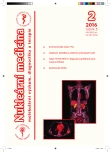18F-FDG PET/CT pitfalls in the diagnostic work-up of inflammation of unknown origin
Authors:
Eva Krčálová 1; Tomáš Kvasnička 2; Eduard Havel 3; Drahomíra Baštecká 4; Jindra Brtková 2; Petr Bradna 4; Jiří Doležal 1
Authors‘ workplace:
Oddělení nukleární medicíny
1; Radiologická klinika
2; Chirurgická klinika
3; 2. lnterní gastroenterologická klinika, Univerzita Karlova v Praze, Lékařská fakulta v Hradci Králové a FN Hradec Králové, ČR
4
Published in:
NuklMed 2016;5:33-36
Category:
Casuistry
Overview
76-year-old female patient with inflammation of unknown origin, also suffering from myalgia and arthralgia underwent 18F-FDG PET/CT imaging. The 18F-FDG PET/CT scan revealed not only the usual polymyalgia rheumatica 18F-FDG uptake pattern, but also 18F-FDG avid expansion in the chest wall and pulmonary nodule with increased 18F-FDG uptake. This nodule could be inflammatory or cancerous. Further assessment did not reveal the nature of pulmonary nodule, but also did not find out evidence for malignancy.
Patient symptoms markedly improved, chest wall expansion regressed fully and the pulmonary nodule partially during the corticotherapy.
18F-FDG PET/CT is a senstitive method which can shorten diagnostic work-up in patients with inflammation of unknown origin. Problematic remains its lower specificity, which may result in subsequent (but already targeted) investigations. Particularly when polymyalgia rheumatica typical 18F-FDG uptake pattern is detected concurrently with 18F-FDG avid lesions atypical for this disease as we present in our case.
Key Words:
inflammation of unknown origin, polymyalgia rheumatica, PET/CT
Sources
1. Balink H, Bennink RJ, Veeger NJ et al. Diagnostic utility of (18)F-FDG PET/CT in inflammation of unknown origin. Clin Nucl Med 2014;39:419-425
2. Řehák Z, Fojtík Z, Staníček K et al. 18F-FDG v diagnostice vaskulitid velkých cév. Vnitř Lék 2006;52:1037-1044
3. Doležal J, Bradna P, Motyčková I et al. Nález vaskulitidy velkých cév při hybridním 18F-FDG PET/CT zobrazení u 57leté pacientky vyšetřované pro váhový úbytek a únavu. Interní Med 2015;17:208-210
4. Rehak Z, Vasina J, Nemec P et al. Various forms of (18)F-FDG PET and PET/CT findings in patients with polymyalgia rheumatica. Biomed Pap Med Fac Univ Palacky Olomouc Czech Repub 2015;159:629-636. doi: 10.5507/bp.2015.026
5. Ramos-Casals M, Brito-Zeron P, Kostov B et al. Google-driven search for big data in autoimmune geoepidemiology: Analysis of 394,827 patients with systemic autoimmune diseases. Autoimmun Rev 2015;14:670-679
6. Pavelka K. Polymyalgia rheumatica – diagnostika a léčba. Postgraduální medicína 2011;13:551-557
7. Yamashita H, Kubota K, Takahashi Y et al. Whole-body fluorodeoxyglucose positron emission tomography/computed tomography in patients with acitve polymyalgia rheumatica: evidence for disctinctive bursitis and large-vessel vasculitis. Mod Rheumatol 2012;22:705-711
8. Ungprasert P, Sanguankeo A, Upala S et al. Risk of malignacy in patients with giant cell arteritis and polymyalgia rheumatica: A systematic review and meta-analysis. Semin Arthritis Rheum 2014;44:366-370
9. Dušek L, Mužík J, Kubásek M et al. Epidemiologie zhoubných nádorů v České republice. Masarykova univerzita. [online]. 2007.[cit. 2015-12-30]. Dostupné na: http://www.svod.cz
10. Dejaco C, Singh YP, Perel P et al. 2015 Recommendations for the management of Polymyalgia Rheumatica. A European League Against Rheumatism/American College of Rheumatology Collaborative Innitiative. Arthritis Rheum 2015;67:2569-2580
Labels
Nuclear medicine Radiodiagnostics RadiotherapyArticle was published in
Nuclear Medicine

2016 Issue 2
Most read in this issue
- 18F-FDG PET/CT pitfalls in the diagnostic work-up of inflammation of unknown origin
- Effectiveness of axillar sentinel lymph node detection
- Match V/Q defect in pulmonary embolism
- Quality control of 223Ra eluate
